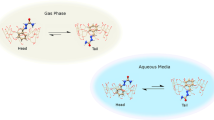Abstract
During crystallization 1,3-cyclohexanedione self assembles into either hydrogen-bonded chains or hexameric rings depending on the solvent conditions. The hexameric rings, called cyclamers, are the subject of this paper. These unusual structures occlude benzene as a guest molecule. The structural and crystal chemical properties of these host-guest compounds are explored here with the use of crystal growth studies, X-ray powder patterns, and thermal analysis. The crystal structure of the benzene cyclamer of 5-methyl-1,3-cyclohexanedione is reported (hexagonal,a =b = 19.19(2)Å,c = 10.545(9)Å,R3,Z = 18,V = 3362(6)Å3; 717 unique reflections,R = 0.062). An analysis of the stereochemical implications of cyclic directionality in these cyclamers is also discussed.
Similar content being viewed by others
References
M. C. Etter, Z. Urbañczyk-Lipkowska, D. A. Jahn, and J. S. Frye:J. Am. Chem. Soc. 108, 5871 (1986).
D. Y. Duchamp and R. E. Marsh:Acta Crystallogr. B25, 5 (1969).
W. A. Denne and R. W. H. Small:Acta Crystallogr. B27, 1094 (1971).
T. P. Lockhart:Organometallics 7, 1438 (1988).
M. C. Etter, Z. Urbañczyk-Lipkowska, T. Ameli, and T. W. Panunto:J. Cryst. Spectrosc. Res. 18, 491 (1988);
M. C. Etter and T. W. Panunto:J. Am. Chem. Soc. 110, 5896 (1988);
M. C. Etter and G. M. Frankenbach:Chem. Materials 1, 10 (1989);
T. W. Panunto, Z. Urbañczyk-Lipkowska, R. Johnson, and M. C. Etter:J. Am. Chem. Soc. 109, 7786 (1987).
D. Semmingsen:Acta Chem. Scand. B28, 169 (1974);
I. Singh and C. Calvo:Can. J. Chem. 53, 1046 (1975).
A. K. Musser and P. L. Fuchs:J. Org. Chem. 47, 3121 (1982);
J. P. Blanchard and H. L. Goering: J. Am. Chem. Soc.73, 5863 (1951).
B. A. Frenz, Enraf-Nonius Structure Determination Package, 4th Ed. B. A. Frenz Associates: College Station, TX 1982.
International Tables for X-ray Crystallography, Vol. 3 (Kynoch Press, Birmingham, 1962, Distr. Kluwer Academic Publishers).
Spectrum was run by the Colorado State University Regional NMR Center.
The rate constant for the loss of benzene was calculated according to several equations derived from different mechanisms for solid state reactions (S. R. Byrn:The Solid-State Chemistry of Drugs, Academic Press (1982)). An Arrhenius plot of ln(k) (using k from the Prout-Tompkins equation, which gave the best fit) vs 1/T gave the energy of activation. The correlation coefficients for the rate equations were approximately 0.90, reflecting the difficulties inherent in quantifying reactions in the solid state.
F. H. Allen, O. Kennard, D. G. Watson, L. Brammer, A. G. Orpen, and R. Taylor:J. Chem. Soc., Perkin Trans. 2, S1 (1987).
A. R. Ubbelhode and K. S. Gallagher:Acta Crystallogr. 8, 71 (1955);
D. Hadzi:Pure Appl. Chem. 11, 435 (1965);
J. Emsley:Chem. Soc. Rev. 9, 91 (1980).
G. Bruni and G. Natta:Recl. Trav. Chim. 48, 860 (1929).
M. D. Singh, J. Siegel, S. E. Biali, and K. Mislow:J. Am. Chem. Soc. 109, 3397 (1987).
At first glance, it appears that C(5) in III cannot be stereogenic since it has two attached identical groups (hydrogens). Upon further consideration, however, it is recognized that the axial and equatorial hydrogens are chemically different in the solid state where conformational interconversions are not taking place.
Concerted proton hopping similar to the mechanism proposed here has been observed for porphyrins in photochemical hole burning experiments (S. Volker and J. H. van der Waals:Mol. Phys. 32, 1703 (1976)).
The enol and keto oxygens occupy diastereomeric positions in the cyclamers, so proton hopping is not a degenerate process, as it would be inA andB.
J. L. Atwood, J. E. D. Davies and D. D. MacNicol (eds):Inclusion Compounds, v. 1–3, Academic Press (1984).
V. M. Bhatnagar,Clathrate Compounds, Chemical Publishing Co., New York, 1970.
Coupling of pi-electrons with hydrogen bonds has been termed resonance assisted hydrogen bonding (G. Gilli, F. Bellucci, V. Ferretti, and V. Bertolasi:J. Am. Chem. Soc. 111, 1023 (1989)).
J. H. Ok, R. R. Vold, R. L. Vold, and M. C. Etter:J. Phys. Chem. 93, 7618 (1989).
Author information
Authors and Affiliations
Additional information
Alfred P. Sloan Foundation Fellow, 1989–1991.
Rights and permissions
About this article
Cite this article
Etter, M.C., Parker, D.L., Ruberu, S.R. et al. Solid-state and inclusion properties of hydrogen-bonded 1,3-cyclohexanedione cyclamers. J Incl Phenom Macrocycl Chem 8, 395–407 (1990). https://doi.org/10.1007/BF01041196
Received:
Accepted:
Issue Date:
DOI: https://doi.org/10.1007/BF01041196




